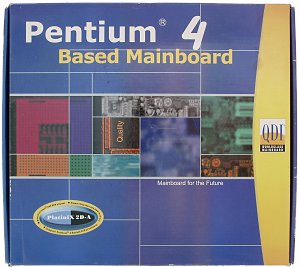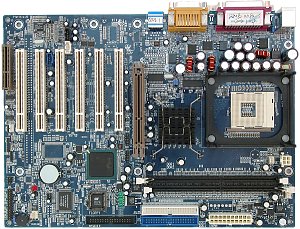QDI PlatiniX 2E-6A (i845E) Mainboard
|


I wish we had the 2EI model instead of the 2E because the former has
an ISA slot, and it might seem more interesting for a number of users.
Accessories:
-
Package of a standard design;
-
Documentation: user manual in English;
-
Cables: 1 ATA66/100/133, 1 ATA33 and FDD;
-
Bracket for the rear computer panel;
-
CD containing:
-
drivers;
-
user manual;
-
Adobe Acrobat Reader;
-
Norton Antivirus 2002;
-
DirectX 8.1
-
Q-Flash (for flashing BIOS from Windows);
-
CBLogo (for changing images in BIOS);
-
QDI StepEasy 2.0.

As a RAID controller is lacking the board has just a couple of flaws
in the layout: audio-ins are in front of the PCI slots and when a video
card is installed it's difficult to handle memory modules. It can be difficult
as well to reach some jumpers when the board is already installed. Their
functions are shown on the textolite.
The 3-channel switching voltage regulator incorporates 12 capacitors
of 3300 uF and 3 of 2200 uF.
The following controllers are integrated:
-
audio controller based on the ALC650 AC'97 codec supporting 5.1 audio systems
and having an SPDIF connector.
The POST controller informs on problems occurred during booting with its
5 green LEDs. When power is supplied to the board, the red LED goes on.
Non-unsoldered connectors: an ISA slot with an LPC controller, a controller
for interface of readers of smart cards and flash cards and its connectors,
a network controller and an RJ45 connector.
The system monitoring is supported by the Winbond W83627HF-AW chip.
What is controlled:
-
voltage of processor, AGP bus, memory, +1.25, +3.3, +5 and +12 V, VBAT
and +5 V Standby;
-
speed of 3 fans;
-
temperatures of the processor (a built-in sensor), the board (a built-in
sensor) and an external sensor connected to the board.
There are 2 connectors for adjustable and 1 for unadjustable connection
of fans.
Brief characteristics of the board: memory slots - 2 DDR SDRAM;
expansion slots - AGP/ 6 PCI/ CNR; I/O ports - 2 COM/ LPT/ 2 PS/2/ 6 USB
2.0; dimensions - 305x225 mm.

Adjustment can be carried out with:
| jumpers and switches |
Jumper to clear up the CMOS |
|
| 2 jumpers for starting up computer from USB keyboard |
|
| 2 jumpers to choose a FSB frequency |
Auto, 66, 100, 133 and 200 MHz |
| Jumper to enable BIOS write protection |
|
| BIOS based on the AWARDBIOS 6.00PG from Phoenix |
Setup of memory timings |
+ |
CAS Latency, Active to Precharge Delay, RAS to CAS Delay, RAS
Precharge |
| Setup of memory frequency |
+ |
Auto, DDR200, DDR266 |
| Setup of AGP bus |
+ |
|
| Setup of PCI bus |
- |
|
| Changeable scaler of AGP and PCI buses |
- |
|
| Manual assignment of interrupts |
- |
|
| Changeable FSB frequency |
+ |
100, 105, 108, 114, 120, 123, 126, 133, 136, 140, 144, 148, 152,
160, 166 MHz |
| Changeable CPU multiplier |
+ |
x8-x23 |
| Changeable core voltage |
+ |
from -0.075 V to +0.3 V in 0.025V steps |
| Changeable memory voltage |
+ |
Normal, +10% |
| Changeable chipset voltage |
- |
|
| Changeable AGP bus voltage |
+ |
Normal, +10% |
We used the latest available version of the BIOS - 1.3.
This is an average board without striking performance, functionality
or overclocking means. The only real advantage is its high quality. And
the 2EI version, as we mentioned above, is more interesting as many users
still have some ISA extension cards.
Test results:
Write a comment below. No registration needed!
|
|
 |
|
|
|



